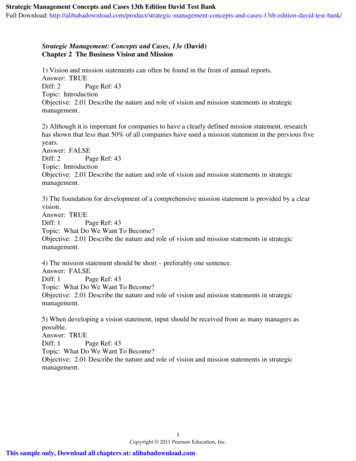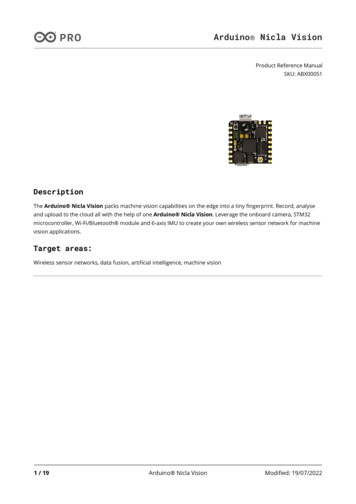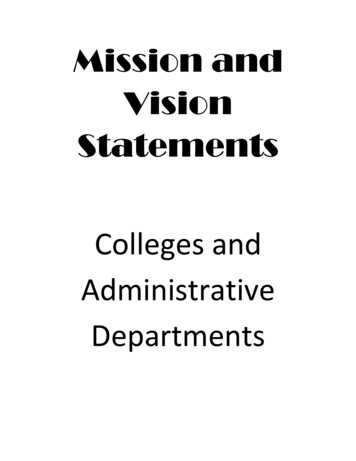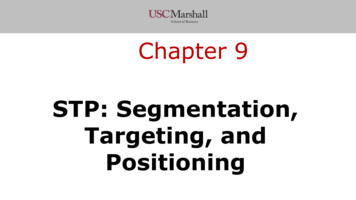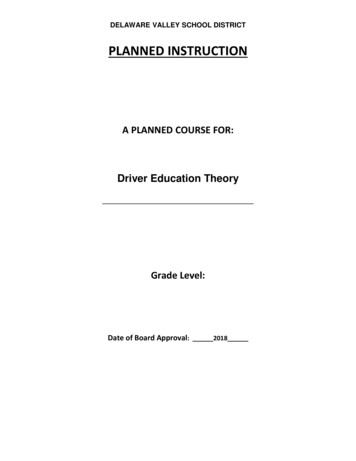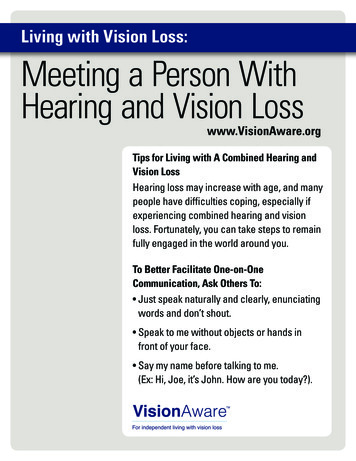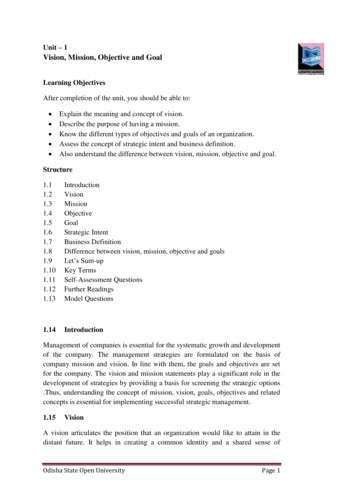
Transcription
Unit – 1Vision, Mission, Objective and GoalLearning ObjectivesAfter completion of the unit, you should be able to: Explain the meaning and concept of vision.Describe the purpose of having a mission.Know the different types of objectives and goals of an organization.Assess the concept of strategic intent and business definition.Also understand the difference between vision, mission, objective and egic IntentBusiness DefinitionDifference between vision, mission, objective and goalsLet’s Sum-upKey TermsSelf-Assessment QuestionsFurther ReadingsModel Questions1.14IntroductionManagement of companies is essential for the systematic growth and developmentof the company. The management strategies are formulated on the basis ofcompany mission and vision. In line with them, the goals and objectives are setfor the company. The vision and mission statements play a significant role in thedevelopment of strategies by providing a basis for screening the strategic options.Thus, understanding the concept of mission, vision, goals, objectives and relatedconcepts is essential for implementing successful strategic management.1.15VisionA vision articulates the position that an organization would like to attain in thedistant future. It helps in creating a common identity and a shared sense ofOdisha State Open UniversityPage 1
purpose. A good vision is one which foster risk taking and experimentation. Itanswers the question: ‘What will success look like?’The vision of an organization must possess the following characteristics: It is created by consensus.It forms a company’s future mental image.It forms the basis for formulating the mission statement.A good vision possesses the following features: It should be inspiring.It should foster long term thinking.It should be original and unique.It should be competitive.It should be realistic.Examples:CompanyWaltDisneyStokesEye ClinicInfosys1.16VisionMake people happyOur vision is to take care of your visionTo be a globally respected organization thatprovides best of breed business solutions,leveraging technology, delivered by best-in-classpeople.MissionMission refers to the purpose of an organization. Mission states the businessreason for the organization's existence. It relates the organization to the society.The mission of an organization should aim high and at the same time it must berealistic. It should provide a strategic direction for the organization.“Missionis the fundamental work given by the society to an organization”.By Koontz & Q’ Ponnell“Thecompany mission is defined as the fundamental unique purpose that sets abusiness apart from other firms of its type & identifies the scope of its operationsin product & market terms”.By Pearce & RobinsonIn order to be effective, a mission statement should possess the followingcharacteristics:Odisha State Open UniversityPage 2
(i) A mission statement should be realistic and achievable. Impossible statementsdo not motivate people.(ii) It should neither be too broad not be too narrow. If it is broad, it will becomemeaningless. A narrower mission statement restricts the activities of organization.The mission statement should be precise.(iii) A mission statement should not be ambiguous. It must be clear for action.Highly philosophical statements do not give clarity.(iv) A mission statement should be distinct. If it is not distinct, it will not have anyimpact. Copied mission statements do not create any impression.(v) It should have societal linkage. Linking the organization to society will buildlong term perspective in a better way.(vi) It should not be static. To cope up with ever changing environment, dynamicaspects should be considered.(vii) It should be motivating for members of the organization and of society. Theemployees of the organization may enthuse themselves with mission statement.(viii) The mission statement should indicate the process of accomplishingobjectives. The clues to achieve the mission will be the motivating factor.Examples:CompanyMayoClinicThe BankofNewYorkNIKE Inc.Mission StatementTo inspire hope and contribute to health and wellbeing by providing the best care to every patientthrough integrated clinical practice, education andresearch.We strive to be the acknowledged global leaderand preferred partner in helping our clients succeedin the world’s rapidly evolving financial markets.To Bring Inspiration and innovation to everyathlete in the world.There are diverse issues which need to be covered while framing the missionstatement of a company. The various components of a well framed missionstatement are stated as follows: Product or serviceCustomersTechnologySurvival, growth and profitabilityOdisha State Open UniversityPage 3
Company philosophyPublic image Check your progressExercise 1Suppose you are appointed as the head of the strategy planning department of aautomobile company dealing in luxury segment cars. Frame a vision andmission statement for the company. Make necessary assumptions. .1.17ObjectiveObjectives are the end results of a planned activity. They are stated in quantifiableterms. Objectives are stated differently at various levels of management.Objectives play a very important role in enhancing the efficiency andeffectiveness of an organization. The following characteristics must be present infairly framed objectives: They should be specific and unambiguous.They should have a particular time horizon within which it is expected tobe achieved.They should be flexible enough so that if changes are required, they maybe incorporated easily.They should be attainable.They should be measurable.They should be understandableThey should help in the achievement of the organization’s mission andvision.They should be challenging.There are many factors which have an impact on the formulation of objectives inan organization. These factors are kept in mind before making objectives. Thesefactors are mentioned as below: Size of the organization.Level of managementOrganization cultureOdisha State Open UniversityPage 4
Social responsivenessObjectives are the milestones expressed in specific terms which a person plan toachieve in a limited time period. Following are a few examples:BasisFinancial ObjectivesMarket CoverageObjectivesTo achieve 10% growth inearning per share.To have 900 millionsubscriber base in thecountry by 2020.Objectives may be of various types. Some of these are explained as below:Profit Objective – It is the most important objective for any business enterprise.In order to earn a profit, an enterprise has to set multiple objectives in key resultareas such as market share, new product development, quality of service etc.These may also be termed as performance objectives.Marketing Objective may be expressed in terms of percentage increase ordecrease in market share. They are related to a functional area.Productivity Objective may be expressed in terms of ratio of input to output.This objective may also be stated in terms of cost per unit of production.Product Objective may be expressed in terms of product development, productdiversification, branding etc.Social Objective may be described in terms of social orientation. It may be treeplantation or provision of drinking water or development of parks.Financial Objective relate to cash flow, debt equity ratio, working capital, newissues, stock exchange operations, collection periods, debt instruments etc.Human resources objective may be described in terms of absenteeism, turnover,number of grievances, strikes and lockouts etc. For example: the objective may beto decrease the rate of absenteeism.1.18GoalGoals are an intermediate result which is expected to be achieved by a certainspan of time. It is a target which an organization wishes to achieve in long term. Itprovides the basis for judging the performance of the organization. Goals may beclassified into two categories: Financial goals: They are related to the return on investment or growth inrevenues.Odisha State Open UniversityPage 5
Strategic goals: They focus on the achievement of the competitiveadvantage in the industry.Goals should be well constructed and realistic in nature. Following are theexamples of well framed goals:BasisCustomer serviceCommunity serviceGoalsProvide quality service tothe customers at least at parwith the highest standard inthe industry.Provide job opportunitieswhich promote a higherstandard of living for allthe citizens. Check your progressExercise 2Assuming yourself the marketing manager of a luxury chain hotel. Frame themarketing objectives. .Odisha State Open UniversityPage 6
1.19Strategic IntentStrategic intent refers to the purpose for which the organization strives for. It isthe philosophical framework of strategic management process. The hierarchyof strategic intent covers the vision and mission, business definition and the goalsand objectives. The following figure indicates the hierarchy of the strategic intentframework:VisionMissionBusiness DefinitionGoalsObjectivesFollowing are the characteristics of strategic intent: It should have an essence of winning.It should remain stable over a period of time.It should encourage personal effort and commitment.It should foster creativity.The strategic intent notion helps the managers to focus on creating newcapabilities to exploit future opportunities.1.20Business DefinitionIt explains business operations of a company stated in terms of customer needs,product specifications and technology.CompanyHULOdisha State Open UniversityBusiness DefinitionTo meet every day needs ofpeople everywhere withbranded products.Page 7
Oerik Abell suggests defining business along the three dimension of customergroups. Customer functions and alternative technologies. They are developed asfollows:i.ii.iii. Customer groups are created according to the identity of the customers.Customer functions are based on provision of goods/services to customers.Alternative Technologies describe the manner in which a particularfunction can be performed for a customer.For a watch making business, these dimensions may be outlined asfollows:Customer groups are individual customers, commercial organizations,sports organization, educational institutions etc.Customer functions are record time, finding time, alarm service etc. It maybe a gift item also.Alternative technologies are manual, mechanical and automatic.The following figure depicts the three dimensions of business rFunctionsAlternativeTechnologiesA clear business definition is helpful in identifying several strategic choices. Thechoices regarding various customer groups, various customer functions andalternative technologies give the strategists various strategic alternatives. Thediversification, mergers and turnaround depend upon the business definition.Customer oriented approach of business makes the organization competitive. Onthe same lines, product/ service concept could also give strategic alternatives froma different angle. Business can be defined at the corporate or SBU levels. At thecorporate level, it will concern itself with the wider meaning of customer groups,customer functions and alternative technologies. If strategic alternatives are linkedthrough a business definition, it results in considerable amount of synergicadvantage.Odisha State Open UniversityPage 8
Check your progressExercise 3Prepare a list of business definitions of any five Fast Moving Consumer GoodsCompanies in India. .1.21Difference between vision, mission, objective and goalsThe concept of vision, mission, objective and goals are interlinked and interrelatedto each other. Besides from this connection there are certain focal points on thebasis of which some differentiation can be done. Following are some distinctionsamong these ptMeasurementTime PeriodActionMissionIt defines the purpose andprimary objectives related toyour customer needs and teamvalues.It answers the question: Howyou will get to where you wantto be?The purpose is to inform whatthe organization does.A mission statement talks aboutthe present which ultimatelyleads to the future.VisionIt communicates both – purposeand values of your business.It answers the question: Whereyou want to be?The purpose is to inspire peopleand motivate their emotionaldrives to achieve it.A vision statement talks about thefuture of the tmenttoachievespecified results in a specifiedperiod of time.It is easy to measure them asthey are generally quantifiable.They are mid-term or short termin nature.GoalsIt refers to the long termpurposewhichanorganizationstrivestoachieve.It is difficult to measure them.It refers to the specific action whichsupports the associated goal.It refers to a generic actiontowards which one strives.Odisha State Open UniversityThey are long term in nature.Page 9
Check your progressExercise 4Differentiate between Business Definition and Strategic Intent. .1.22Let’s Sum-upEvery business organization is incorporated with a common aim to achieveheights in their respective industries. This calls for the setting up of an inspiringvision, motivating mission, goals and objectives. This forms a hierarchy which isstated as Strategic Intent. Apart from these, the business definition must bespecified to have a clarity about the customer groups it wants to cater, possibleproducts which could be offered and the alternative technologies which may beemployed.1.23Key TermsVision: Vision serves the purpose of stating what an organization wishes toachieve in the long run.Mission:A written declaration of an organization's core purpose and focus thatnormally remains unchanged over time.Objective:Objectives refer to the ultimate end results which are to beaccomplished by the overall plan over a specified period of time.Goal: Goals denote a broad category of financial and non-financial issues that afirm sets for itself.Strategic Intent: The strategic intent concept encompasses an active managementprocess that includes focusing the organization’s attention on the essence ofwinning.Business Definition: It explains business operations of a company stated in termsof customer needs, product specifications and technology.1.24 Self-Assessment Questions1. What is the need of setting objectives in an organization?2. Differentiate between vision and mission.Odisha State Open UniversityPage 10
1.25Further Readings J. David Hunger & Thomas L. Wheelen, Strategic Management, AddisonWesley Longman. Azhar Kazmi, Business Policy & Strategic Management, Tata McGrawHill. Thompson & Strickland, Strategic Management-Concepts and Cases, TataMcGraw Hill. Garth Saloner, Andrea Shepard and Joel Podolny, Strategic Management,John Wiley & Sons.1.26Model Questions1. What do you understand by vision? Explain with the help of an example.2. Discuss the various areas in which objectives may be set.3. Differentiate between goals and objectives.4. Write a short note on Business Definition.5. Explain the concept of Strategic Intent.Answer to Self-Assessment Questions1. The following points specifically emphasize the need for establishingobjectives: Objectives provide yardstick to measure performance of a department orSBU or organization.Objectives serve as a motivating force. All people work to achieve theobjectives.Objectives help the organization to pursue its vision and mission. Longterm perspective is translated in short-term goals.Objectives define the relationship of organization with internal andexternal environment.Objectives provide a basis for decision-making. All decisions taken at alllevels of management are oriented towards the accomplishment ofobjectives.Odisha State Open UniversityPage 11
2. Following are the differences between mission and vision:BasisConceptAnswerPurposeTimeFrameMissionIt defines the purpose andprimary objectives related toyour customer needs and teamvalues.It answers the question: Howyou will get to where you wantto be?The purpose is to inform whatthe organization does.A mission statement talks aboutthe present which ultimatelyleads to the future.Odisha State Open UniversityVisionIt communicates both –purpose and values ofyour business.It answers the question:Where you want to be?The purpose is to inspirepeople and motivate theiremotionaldrivestoachieve it.A vision statement talksabout the future of theorganization.Page 12
Unit – 2Porter’s 5-Forces ModelLearning ObjectivesAfter completion of the unit, you should be able to: Explain the Porter’s 5-Forces Model.Describe the basic components of Porter’s 5-Forces Model.Understand the process of conducting industry analysis through Porter’s 5Forces Model.Know the benefits of Porter’s 5-Forces .112.122.132.142.1IntroductionPorter’s 5-Forces ModelThreat of New EntrantsThreat of SubstitutesBargaining Power of CustomersBargaining Power of SuppliersRivalry among Existing FirmsProcess of conducting industry analysis through Porter’s 5-Forces ModelBenefits of Porter’s 5-Forces AnalysisLet’s Sum-upKey TermsSelf-Assessment QuestionsFurther ReadingsModel QuestionsIntroductionStrategy formulation is an important part of every business organization. Beforeframing the strategy, environment scanning needs to be done. Business has twotypes of environment which need to be assessed – Internal and External. To carryout this environment analysis in a systematic manner, Michael Porter hassuggested a model which is popularly known as Porter’s 5-Forces Model. Thismodel is also used for industry analysis. It is explained in the coming paragraphs.2.2Porter’s 5-Forces ModelPorter's Five Forces of Competitive Position Analysis were developed in 1979 byMichael E Porter of Harvard Business School as a simple framework for assessingand evaluating the competitive strength and position of a business organisation.Odisha State Open UniversityPage 13
This theory is based on the concept that there are five forces that determine thecompetitive intensity and attractiveness of a market. Porter’s five forces help toidentify where power lies in a business situation. This is useful in understandingthe strength of an organisation’s current competitive position.Strategic analysts often use Porter’s five forces to understand whether newproducts or services are potentially profitable. By understanding where power lies,the theory can also be used to identify areas of strength, to overcome weaknessesand to avoid mistakes.The five competitive forces plays an important role in determining theprofitability in any industry. These five competitive forces are: The threat of new entrantsThe threat of substitute products or servicesThe bargaining power of customersThe bargaining power of suppliersThe rivalry amongst current competitors in the industry.Whatever the industry, these five competitive forces are central to formulating andimplementing business strategy. The relative strength of each competitive forcetends to be a function of industry structure i.e. its underlying economic andtechnological characteristics. This can change overtime, with the result that therelative strength of competitive forces will also change, hence the industry’sprofitability. The porter’s five competitive forces model is powerful and widelyused tool for systematic diagnosis of principal competitive pressures prevailing inthe industry and assessing the strength and importance of each such force on theparticular firm in the industry.Porter’s Five Forces ModelPotential EntrantsBargaining PowerSuppliersof SuppliersThreat of NewEntrantsIndustryBargaining PowerCompetitorsRivalry amongof BuyersExisting firmsThreat of SubstituteProducts or ServicesSubstitutesThe above mentioned five forces are explained next page.Odisha State Open UniversityPage 14Buyers
2.3Threat of New EntrantsThe new entrants represent the firms that are outside the particular firm’s industryand contemplating entry into the industry. A new entrant will bring extra capacityinto an industry. This poses a threat to established firms because they may losemarket share with a consequent potential loss of economies of scale. The threat ofentry will place a limit on prices and shapes the investment requirement todiscourage entrants.Porter list main barriers to entry as:a.b.c.d.e.f.Economies of scaleProduct differentiationCapital requirementsSwitching costsAccess to distribution channelsGovernment policyThe new entrant firm may bring with it new technology, innovative ideas,substantial resources, new and quality products. The greater the power andresources the new entrant has, the greater will be the probability that it will eataway the market share of existing firms. The strength of the threat from newentrant depends on the strength of the barriers to entry and the likely response ofexisting competitors to the new entrants. The entry barriers are not static. Theycan be raised by a number of measures and also might be lowered by changes inthe environment. Check your progressExercise 1Suppose you are amongst the strategic planning team in a leading hospital.Prepare a list of competitors and potential entrants in the business. .2.4Threat of SubstitutesThe products or services that are produced in one industry are likely to havesubstitutes that are produced in another industry which satisfy the same customerneed. Substitute products or services are those that apparently are different, butOdisha State Open UniversityPage 15
satisfy the same set of customer needs. The availability of close substituteconstitutes are more attractive than those that have one or more such substitutes.When firms in an industry are faced with threats from substitute products they arelikely to find that demand for their products is relatively sensitive to price.Substitutes limit the potential returns of an industry by placing a ceiling on theprices firms in the industry can profitably change. The substitute products offeringa price advantage or performance improvement to the consumer can significantlyaffect the competitive character of an industry.Porter suggests that those substitutes which should be monitored most closely are: Those products which are providing a better performance / price standardthan the industry standard. Products produced by industries earning high profits.2.5Bargaining Power of CustomersCustomers require better quality products and services at a lower price. If theyhave the power to get what they want, they will force down the profitability of anindustry and it is, therefore, dependent very much on the consumer’s bargainingpower. The strength of the threat from the bargaining power of customers willdepend on a number of factors including the level of differentiation amongstproducts in the industry, the cost to the customer of switching from one supplierto another and whether a customer’s purchases from an industry represent a largeor small proportion of the customer’s total purchases.Porter identified that power of customers seems to be strongest when thefollowing conditions apply: The concentrated purchases of large volumes relative to seller sales.The products it purchases represent a significant fraction of the buyer’scost of purchases.The products it purchases from the industry are standard orundifferentiated.Less switching costs.It earns low profits.The buyers will pose a credible threat of backward integration.The industry’s product is unimportant to the quality of the buyer’s product.The buyer has full information.Buyers must be willing to pay a price for a product that exceeds the sellers’ costof production; otherwise the industry cannot survive in the long-run. On accountof competition, users of industrial products may come together formally orinformally and exert pressure on producer in matters such as price, quality, andOdisha State Open UniversityPage 16
delivery. A high buyer bargaining power constitutes a negative feature for existingfirms or new entrants of an industry. The more powerful buyers from an industryare, the greater will be their influence on the industry in general and its profits inparticular.2.6Bargaining Power of SuppliersThe bargaining power of suppliers determines the cost of raw material and otherinputs. The business of a firm is to a great extent dependent upon its supplierswho supply it with resources like raw materials, spare-parts, equipment,machineries, labour and other supplies. The ability of suppliers to get higherprices depends on a number of factors including the number of suppliers in theindustry, the importance of the supplier’s product to the firm, the cost to the firmof switching from one suppliers to another and the case with which the suppliercould integrate forward.According to Porter, the main determinants of suppliers having power over anindustry occur when: It is dominated by a few companies and is more concentrated than theindustry to which it sells. It is not obliged to contend with other substitute products for sale to theindustry. The industry is not an important customer of the supplier group. The supplier’s products are differentiated or it has built-up stitching costs. The supplier poses a credible threat of forward integration. Check your progressExercise 2State the situations in which the buyer’s will have a weak bargaining power. .2.7Rivalry among Existing FirmsThe intensity of rivalry among existing competitors will influence prices as wellas certain other areas like advertising, sales, promotion, product development etc.Odisha State Open UniversityPage 17
The intensity of competitive rivalry within an industry will affect the profitabilityof industry as a whole.According to Porter, rivalry is intensified by the following factors: Numerous or equally balanced competitorsSlow industry growthHigh fixed or storage costsLack of differentiation or switching costsCapacity augmented in large incrementsDiverse competitorsHigh strategic stakesHigh exit barriersThe intensity of rivalry plays a major role in determining whether existing firmswill expand capacity aggressively or choose to maintain profitability. Althoughrivalry can be beneficial in helping the industry to expand, it might leave demandunchanged. The intensity of competition will depend on a number of factorsincluding the rate of growth in the industry and whether there are a large numberof equally balanced competitors.The intensity of competition depends on several factors as mentioned below: Where large numbers of equally balanced competitors exist, in situation ofintense competition, firms may try to avoid competing on price.Where the growth rate of the industry is slow or stagnant, rivalry mayintensify and the firms may indulge in competing with each other for agreater market share.
Odisha State Open University Page 1 Unit - 1 Vision, Mission, Objective and Goal Learning Objectives After completion of the unit, you should be able to: Explain the meaning and concept of vision. Describe the purpose of having a mission. Know the different types of objectives and goals of an organization.

